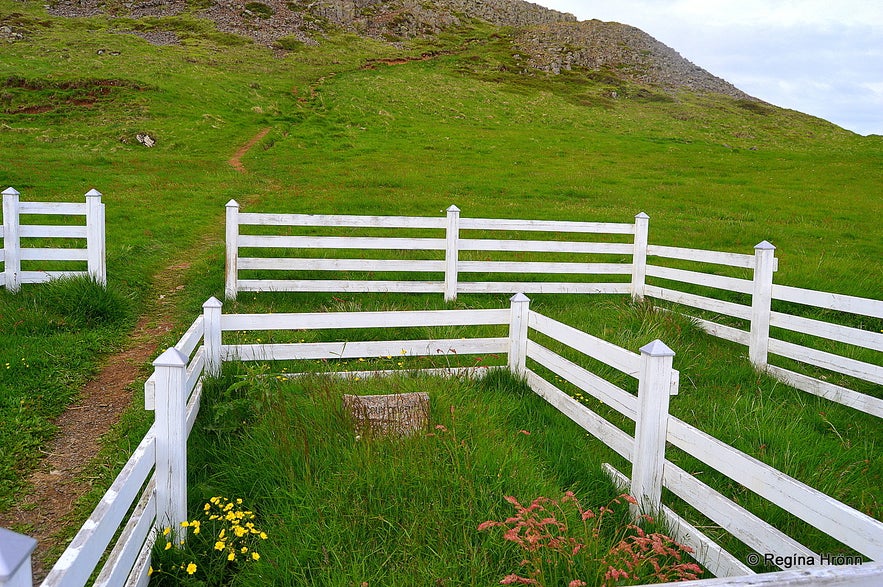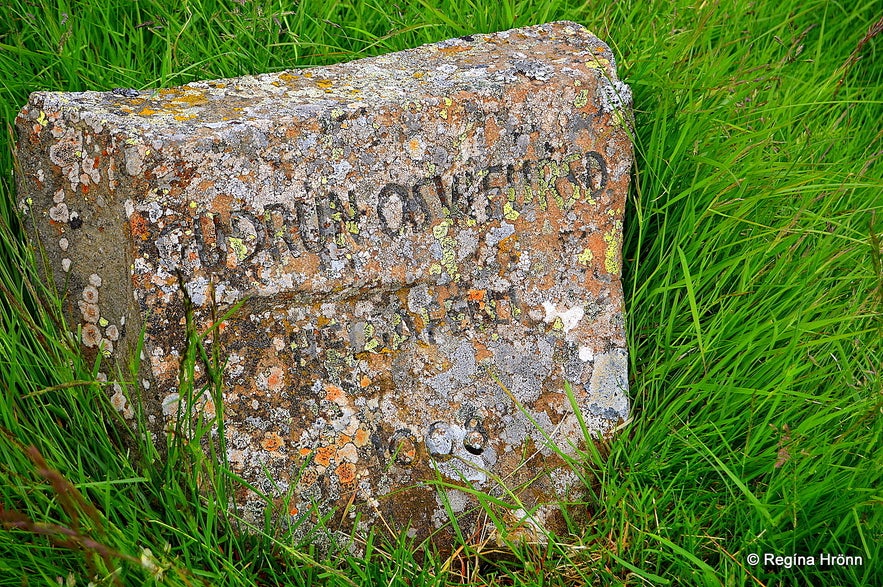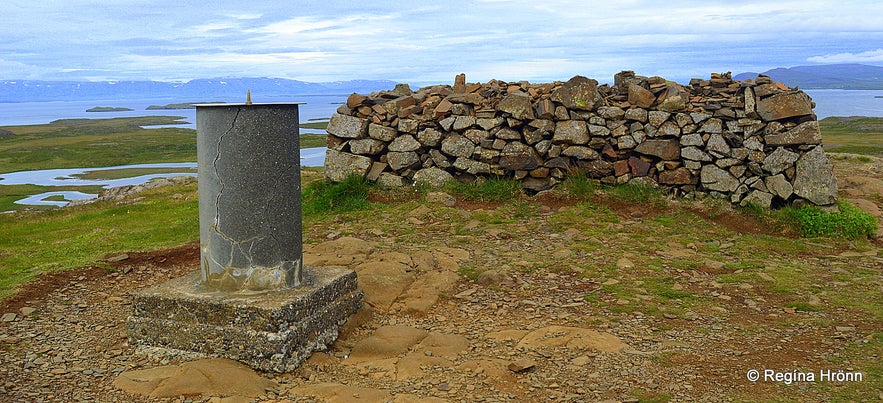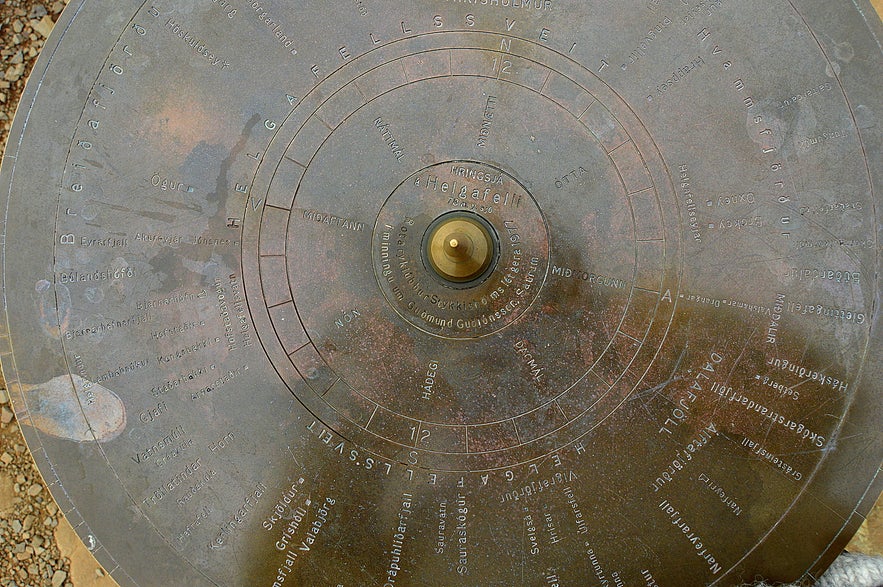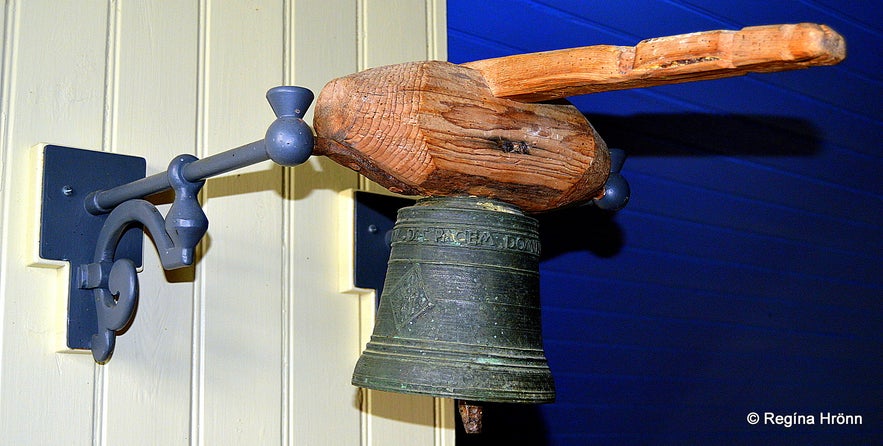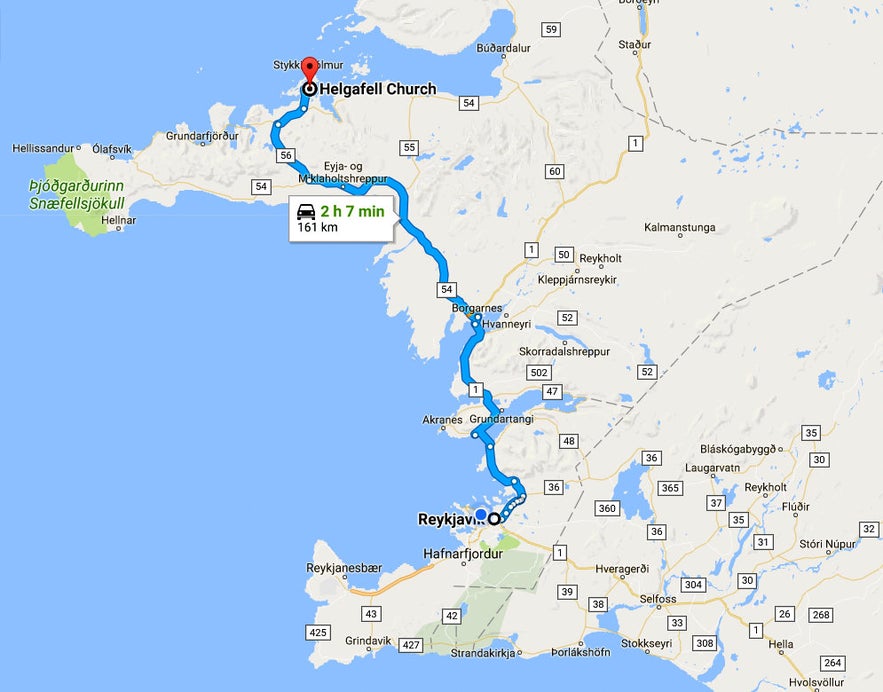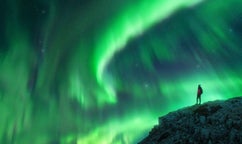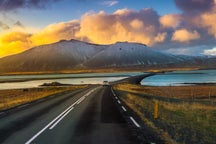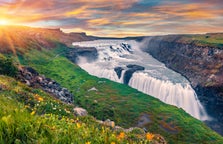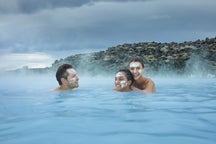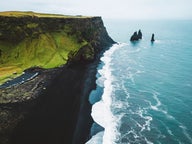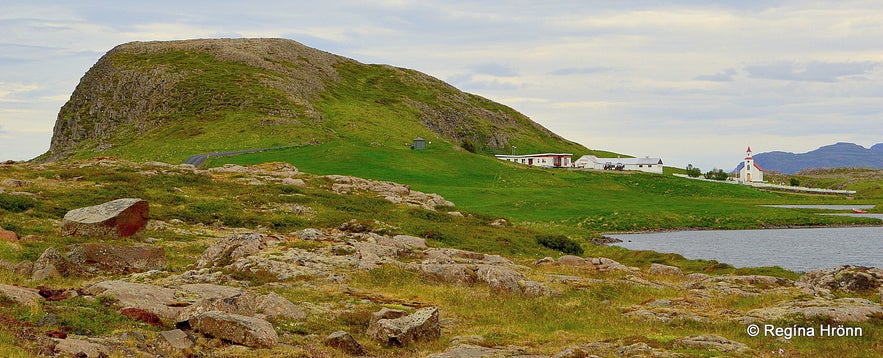
The historic Mt. Helgafell - the Sacred Hill - on the Snæfellsnes peninsula is, in the eyes of many of us Icelanders a sacred place.
It is a common belief amongst the locals that if you hike to the top of the mountain without looking back or uttering a word, you will get 3 wishes fulfilled.
This only works the first time you hike the mountain though, so most Icelanders have already done this hike and received their wishes.
Top photo: Mt. Helgafell
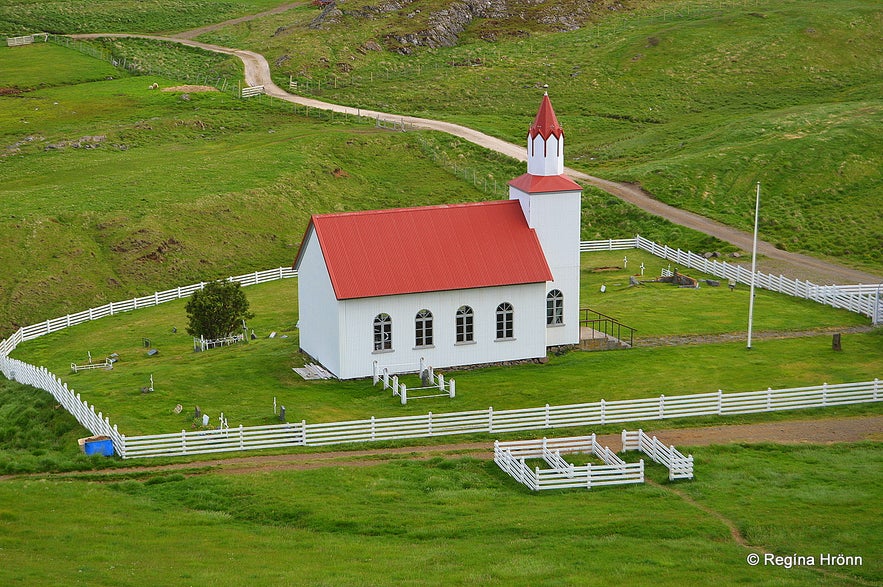
Helgafellskirkja church
Mt. Helgafell is 73 meters tall, and it takes about 8-10 minutes to hike to the top, if that, as the ascent has been made easier now.
You can see Mt. Helgafell from afar, and it looks quite tall, but when you get closer to it, it looks much smaller.
From the top, you will be rewarded with a great view of the Breiðafjörður bay and the surrounding areas.
I found it so lovely to read one comment on my travel-blog when we posted it on the Facebook page of Guide to Iceland.
There, Sarah Braun told us what happened when she made a wish on top of Mt. Helgafell: "We were there on the 4th of October 2016. My wish was a marriage proposal. On the same night, my boyfriend proposed to me under the Northern lights" :)
So you see that some wishes made on Mt. Helgafell do come true :)
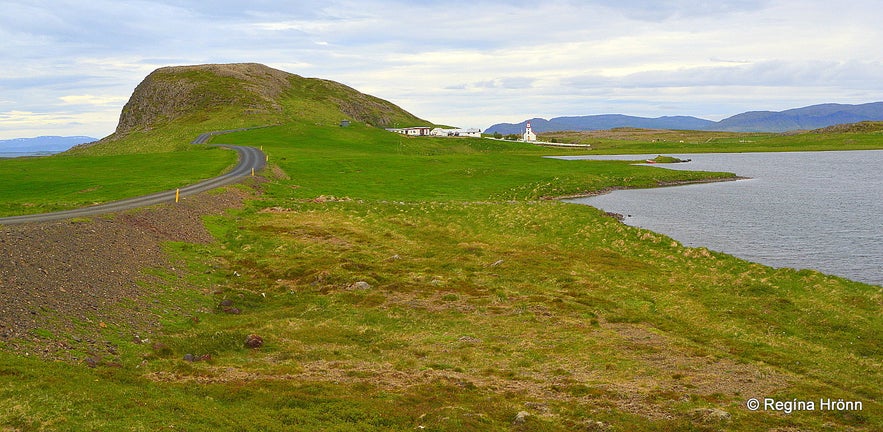
Helgafell
At Helgafell was a wealthy Augustinian monastery, which was a well-known seat of learning, from 1184 until the Reformation in 1550. This monastery was moved from Flatey island to Helgafell.
There has been a church here since the adoption of Christianity in Iceland in the year 1000.
The current church beneath Mt. Helgafell was built in 1903 and consecrated in 1903. That same year, in 1903, my grandfather was born at Fróðá farm in the vicinity.
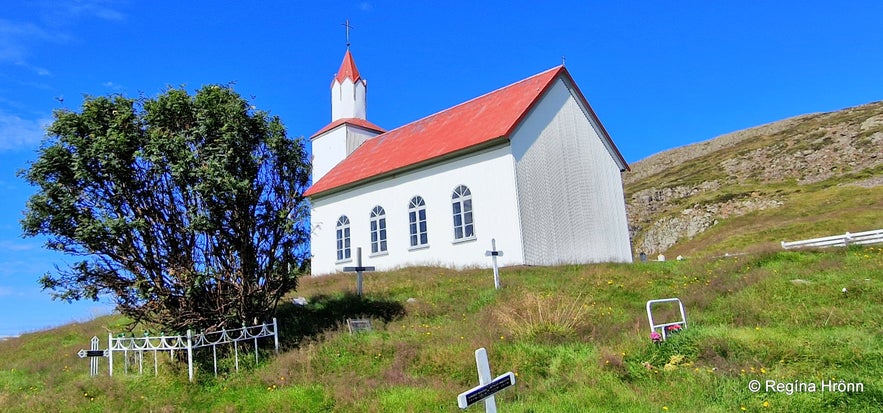 Helgafellskirkja church and Mt. Helgafell
Helgafellskirkja church and Mt. Helgafell
Mt. Helgafell is mentioned in the 33rd chapter of Landnáma - the Book of Settlement: Þórólfur (mostrarskegg) settled land from Stafá river to Þórsá river and called it Þórsnes peninsula.
He so highly revered a mountain that stood on the peninsula, which he called Mt. Helgafell, that no man should look in its direction unwashed.
And it was so sacred that nothing should be killed on the mountain, neither livestock nor men. And he believed that when he and his kinsmen died, they would go inside the mountain.

Mt. Helgafell
Eyrbyggja Saga, which is an excellent Icelandic Saga, takes place in West Iceland and tells us that Þorsteinn þorskabítur, the son of the settler Þórólfur mostrarskegg, was the first one to live at Helgafell. His sons were Börkur digri (the stout) and Þorgrímur.
Þorsteinn þorskabítur had a son called Börkur the stout. The summer when Þorsteinn was 25 years old Þóra, his wife, gave birth to a son.
He got the name Grímur. Þorsteinn gave his son to Þór, the God of Thunder, and named him Þorgrímur. 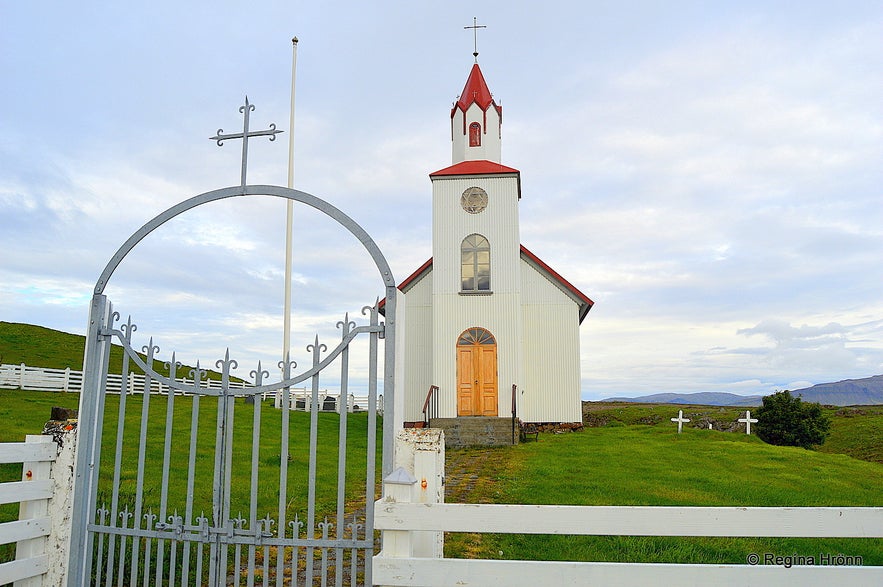
Helgafellskirkja church
That same autumn, Þorsteinn went to Höskuldsey island to fish. One night, his shepherd searched for sheep north of Mt. Helgafell.
He saw the northern side of the mountain opening up.
Inside the mountain, he saw large fires and heard noisy merriment and the sounds of a party.
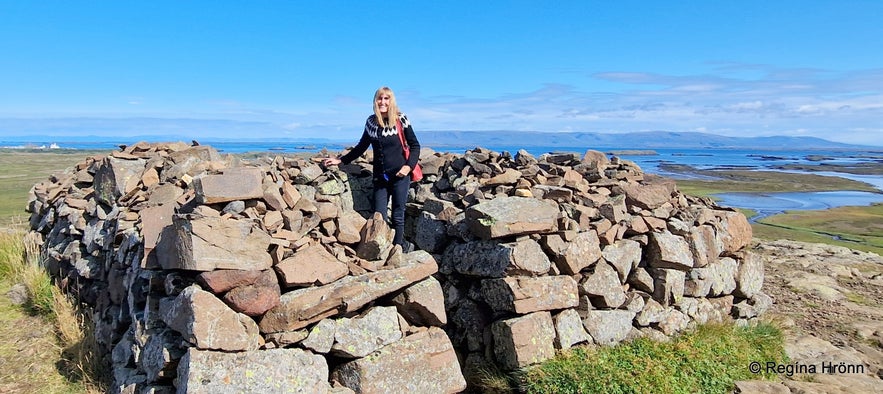 On top of the holy Mt. Helgafell
On top of the holy Mt. Helgafell
He listened carefully to find out if he was able to make out the words. He heard that Þorsteinn þorskabítur and his men were being greeted.
And he heard that Þorsteinn þorskabítur was to sit opposite the high seat of his father.
The morning after, they got the news that Þorsteinn þorskabítur had drowned while fishing.
Haukadalur in Dýrafjörður
Þorgrímur, the son of Þorsteinn þorskabítur, was married to Þórdís, the sister of Gísli Súrsson from the Saga of Gisli the Outlaw.
Gísli killed Þorgrímur, his brother-in-law, when his sister Þórdís was pregnant and the married couple was asleep in their bed closet at Sæból in Haukadalur in Dýrafjörður in the Westfjords.
Gísli was obliged to revenge another brother-in-law, Vésteinn, whom he believed Þorgrímur had killed. Behind the killings was deep-seated jealousy.
I have written about these events in another travel-blog: The Saga Locations of Gísli the Outlaw Súrsson in the Westfjords of Iceland.
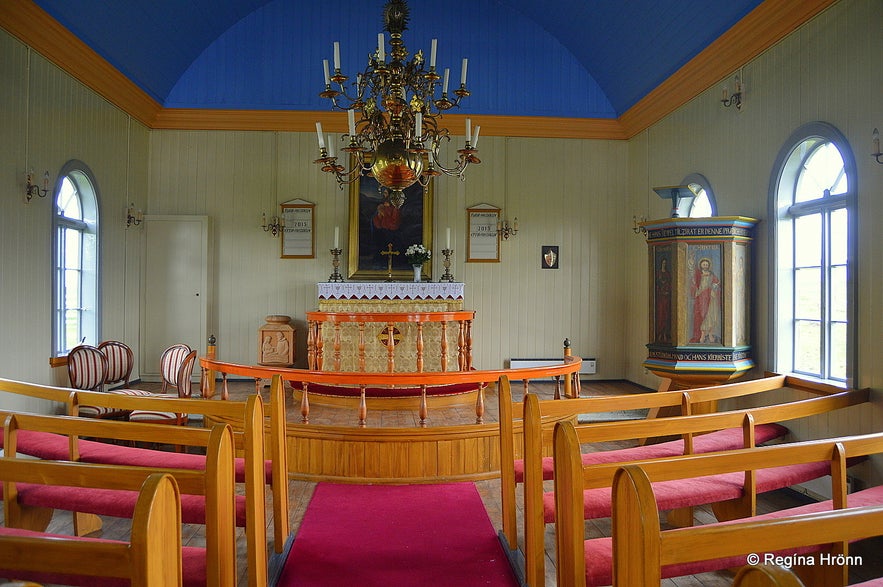
Inside Helgafellskirkja church
The son of Þorgrímur and Þórdís was the noted Snorri goði Þorgrímsson (964-1030) at Helgafell.
He was named Þorgrímur after his father when he was born, but he was born after his father's death.
He was a bit unruly when he was a young boy, so he got the nickname Snerrir, which then stuck with him as Snorri.
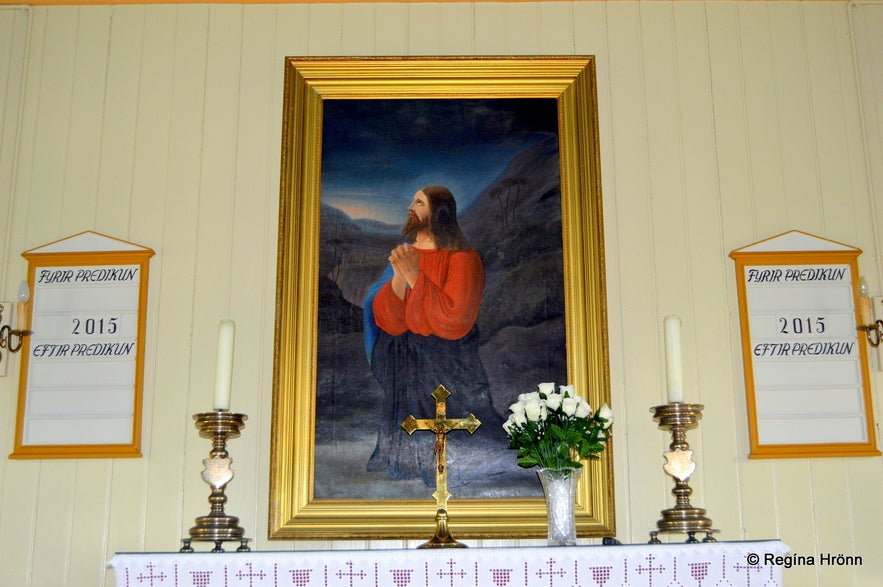
Inside Helgafellskirkja church
After Þorgrímur was killed, Þórdís married his brother Börkur, and they moved to Helgafell.
Börkur and Snorri didn't get along, and later on, Snorri bought Helgafell from his uncle Börkur.
That same day, Þórdís divorced Börkur, and he went on his way according to Eyrbyggja. Þórdís then continued living at Helgafell with her son Snorri.
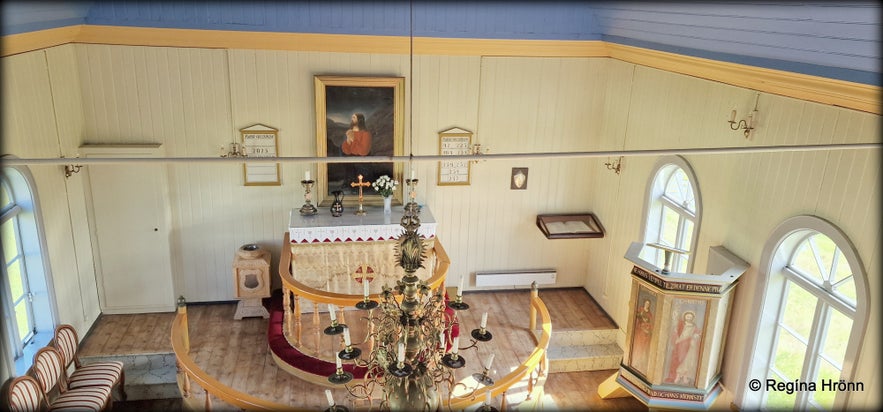 Inside Helgafellskirkja church in 2025 - the light was not favourable
Inside Helgafellskirkja church in 2025 - the light was not favourable
The Saga of Gísli the Outlaw tells the story a bit differently, that Þórdís divorced Börkur after Eyjólfur grái, who killed her brother Gísli with his men, came for a visit, and Þórdís attacked him after learning that her brother had been killed.
She then divorced Börkur and went to live at Þórdísarstaðir farm on Öndverðareyri (Eyri). And that Börkur lived at Helgafell until Snorri managed to drive him away.
Snorri is one of the main characters of Eyrbyggja, which is a very eventful Saga, filled with Viking battles, revenge, and ghost stories.
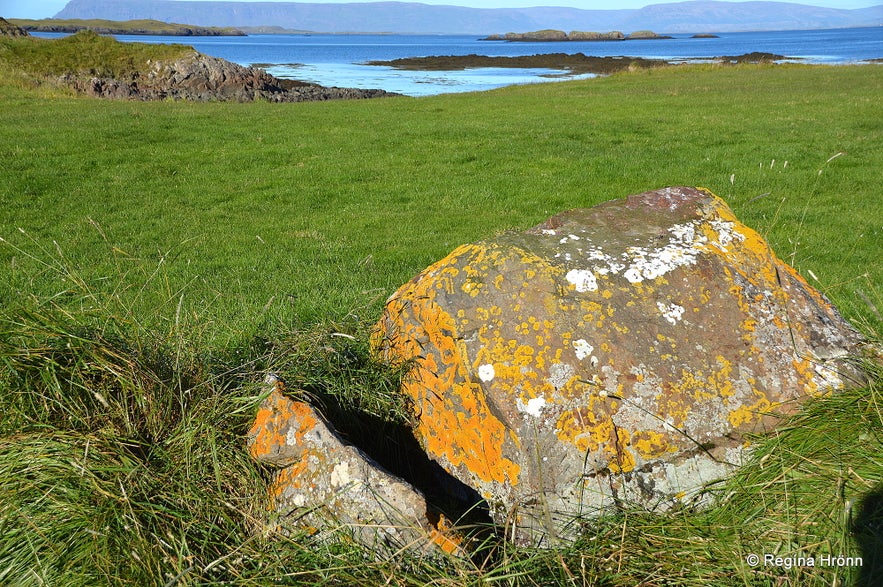
Þórssteinn rock at Þingvellir in Þórsnes, where the quarter parliament Þórsnessþing was located
Eyrbyggja Saga also tells us in detail about the quarter parliament Þórsnessþing. A must-read in my opinion.
In the 10th chapter of Eyrbyggja Þórssteinn rock is described: "There is yet to be seen the Doom-ring, where men were doomed to the sacrifice.
In that ring stands the Stone of Thor over which those men were broken who were sacrificed, and the colour of the blood on that stone is yet to be seen."
Thank God, I must say, for sending us Jesus Christ, so that human sacrifices stopped in Iceland.
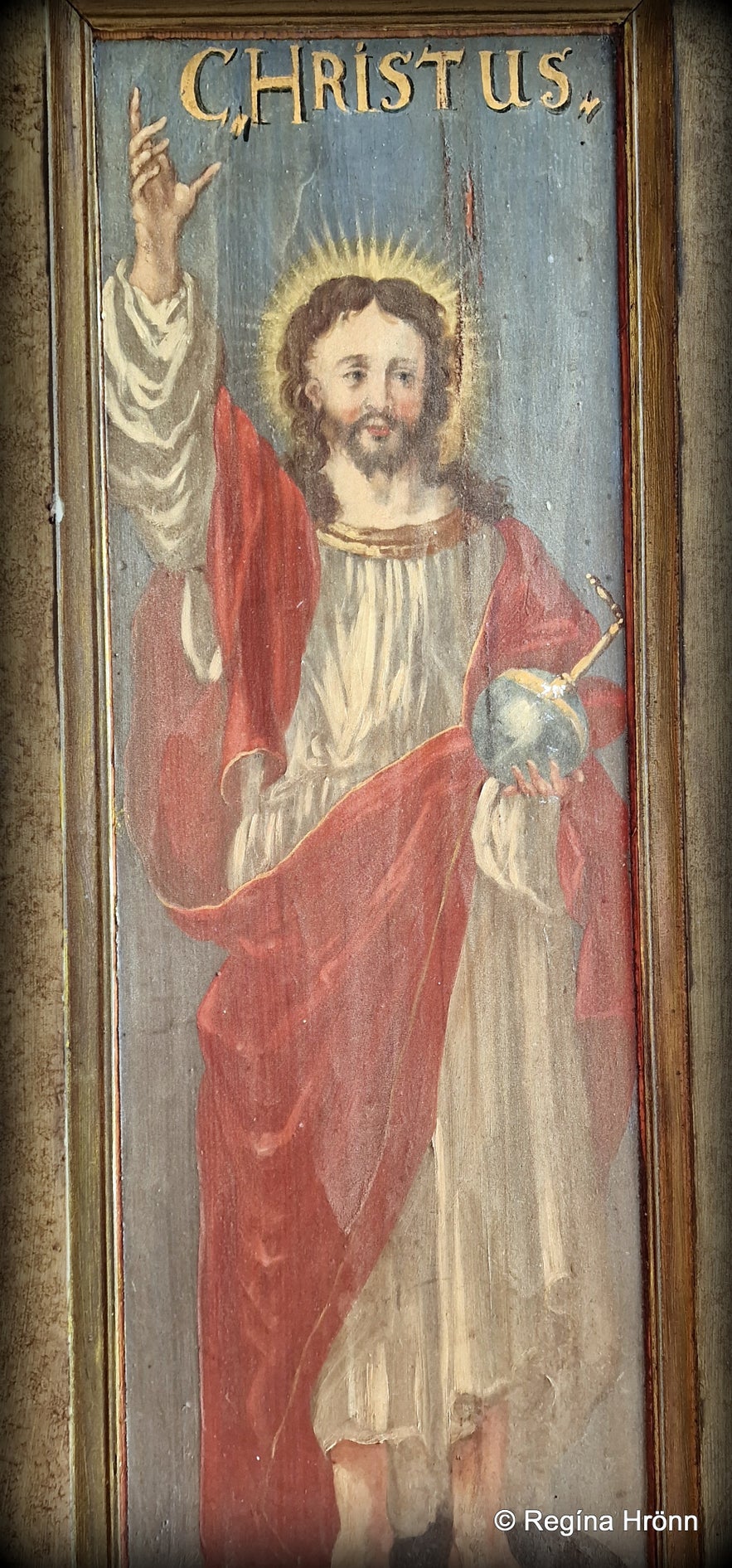 The old pulpit in Helgafellskirkja church
The old pulpit in Helgafellskirkja church
The quarter parliament site on Þórsnes is called Þingvellir, much like the main Þingvellir parliament site, which was established in 930. And here you will also find Lake Þingvallavatn.
And I have heard that tourists have followed their GPS all the way to Þingvellir at Þórsnes, when they meant to visit the Þingvellir where the tectonic plates meet!
In my photo below, you can see Þingvallaborg and what we believe to be the site of the Þórsnessþing parliament.
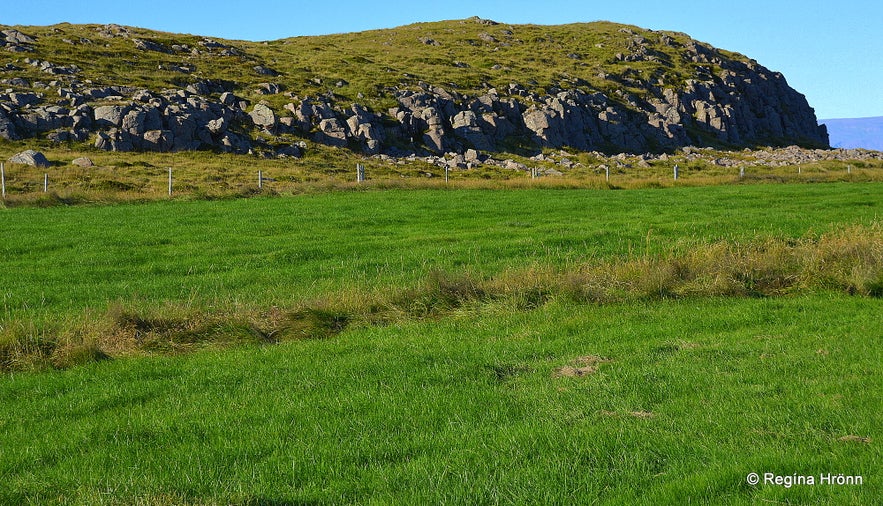
Þórsnessþing quarter parliament
In 1008, when Snorri goði grew older, he switched properties with Guðrún Ósvífursdóttir (approx. 970) from Sælingsdalur, which is relatively close by.
Snorri is my ancestor 27 generations back. And Guðrún is also my ancestress 27 generations back :)
Guðrún Ósvífursdóttir was one of the best-known characters in the Icelandic Sagas, but Guðrún's story is told in Laxdæla Saga.
I have written a travel-blog about Sælingsdalur where I tell you about Guðrúnarlaug hot tub and the story of Guðrún.
Is this the grave of Guðrún Ósvífursdóttir?
You can see what we Icelanders like to consider to be her grave north of the church.
It is almost startling seeing 1008 written on the memorial stone (which is the year Guðrún moved to Helgafell), and sitting by the grave makes me feel closely connected to my heritage.
The memorial stone is made out of rock from the sacred Mt. Helgafell and was erected in 1979.
The grave is outside the graveyard by Helgafellskirkja church and faces the church.
The memorial stone on Guðrún's grave in 2015
Guðrún was married 4 times in her lifetime, but later became a nun at Helgafell and lived there to her old age.
I read Laxdæla Saga when I was in college, and I reread it and all the other 40+ Sagas during the pandemic. I recommend reading Laxdæla Saga if you want to read an Icelandic Saga.
It tells the story of Guðrún Ósvífursdóttir, Bolli Þorleiksson, and Kjartan Ólafsson, who made up the best-known love triangle in the Icelandic Sagas.
These young men both loved Guðrún, who was more experienced and already a widow.
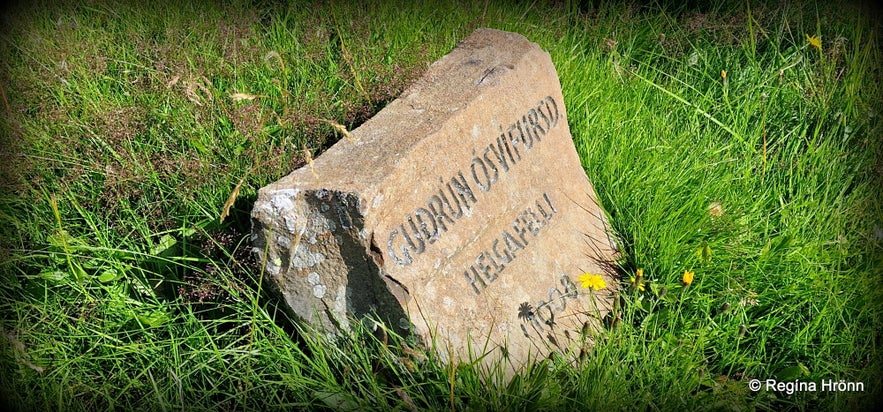 The memorial stone of Guðrún in 2025 - it had been cleaned of all the moss that covered it
The memorial stone of Guðrún in 2025 - it had been cleaned of all the moss that covered it
By tricking Guðrún and telling her that Kjartan, who was abroad at the time, no longer loved her, Bolli convinces Guðrún to marry him, although she was very reluctant to do so as she loved Kjartan.
All Icelanders are familiar with the famous quote from Laxdæla.
Guðrún is asked whom she loved the most, and she replies: "Þeim var ég verst, er ég unni mest" meaning: "To him I was worst whom I loved best".
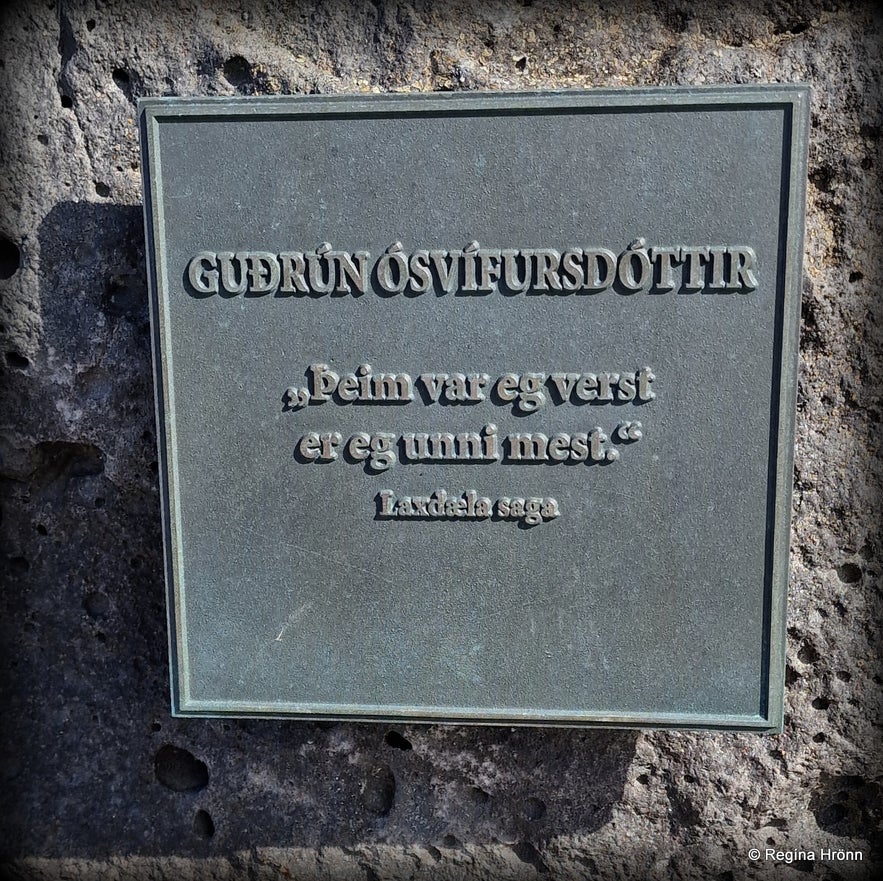 A rock at the beginning of the hike with the famous quote from Laxdæla Saga
A rock at the beginning of the hike with the famous quote from Laxdæla Saga
Two scenes in Laxdæla make my heart ache, the scene when Bolli kills his best friend and blood brother, Kjartan, which is heartbreaking to read.
And when Höskuldur beds the young Irish slave and princess Melkorka the night after he bought her from the slave market, and impregnates her.
Hiking on Mt. Helgafell
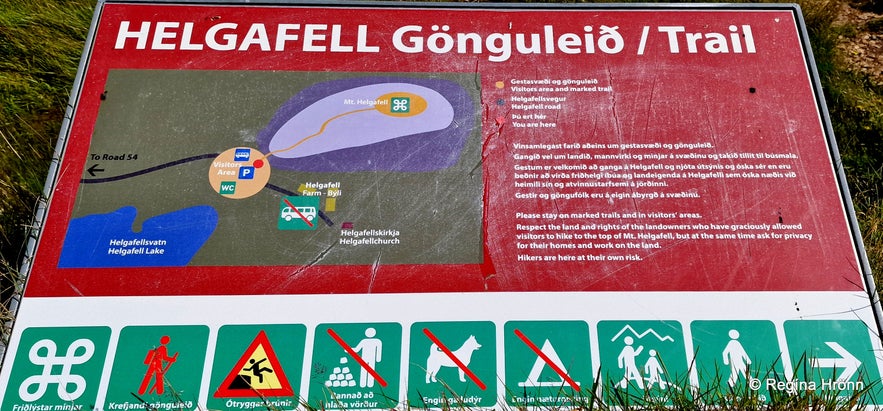 Mt. Helgafell hiking trail
Mt. Helgafell hiking trail
It has become increasingly popular to hike on the holy Mt. Helgafell.
Earlier on, only Icelanders would hike to the top, but with the increase in tourism in Iceland, there is now almost a constant line of visitors to Helgafell.
The Helgafell farm is privately owned and has been in the same family since 1888.
The farmer is constantly maintaining the trails and picking up trash that has been left behind.
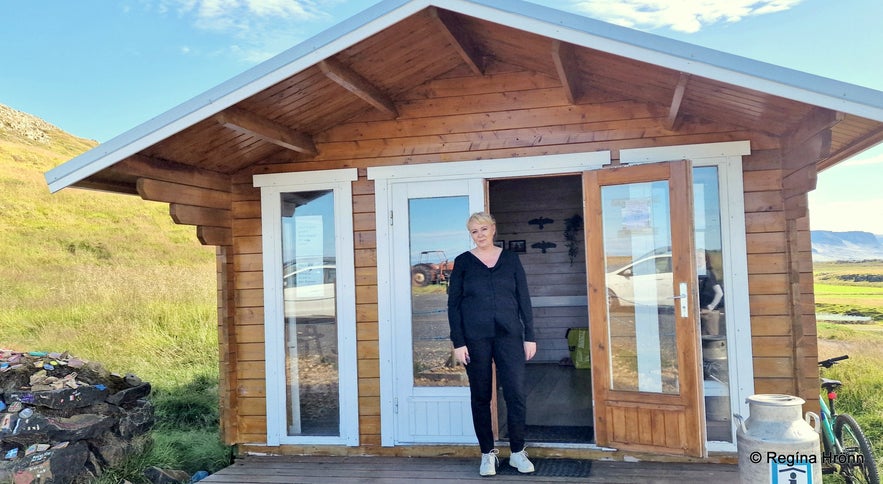 Jóhanna Kristín, the farmer at Helgafell, greets visitors. The entrance fee is ISK 650
Jóhanna Kristín, the farmer at Helgafell, greets visitors. The entrance fee is ISK 650
The farmers received a grant from Framkvæmdasjóður ferðamannastaða in 2014 to repair the damages already done to Helgafell by the myriad of visitors, but were denied a grant in 2015 and 2016 to finish this task.
But visitors kept coming to Helgafell, and the farmers had to do something, so now the farmers at Helgafell are asking visitors, 12 years and older, to pay ISK 650 to visit Mt. Helgafell.
They now have an employee supervising Helgafell, as an estimated 300+ visitors visit Helgafell every day in the summertime!
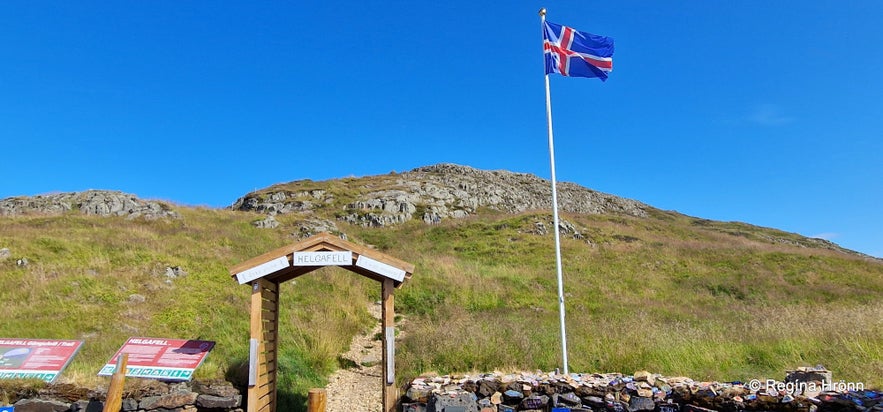 The entrance gate by the parking lot marks the beginning of the hike to the top of Mt. Helgafell
The entrance gate by the parking lot marks the beginning of the hike to the top of Mt. Helgafell
I support them in charging visitors this small maintenance fee, as visitors were even barging into their home to use their WC! It is not easy to have a farm on such a historic site.
There is now a WC on site for customers.
The hike on Mt. Helgafell traditionally started by the grave of Guðrún outside the graveyard on the east side of the mountain.
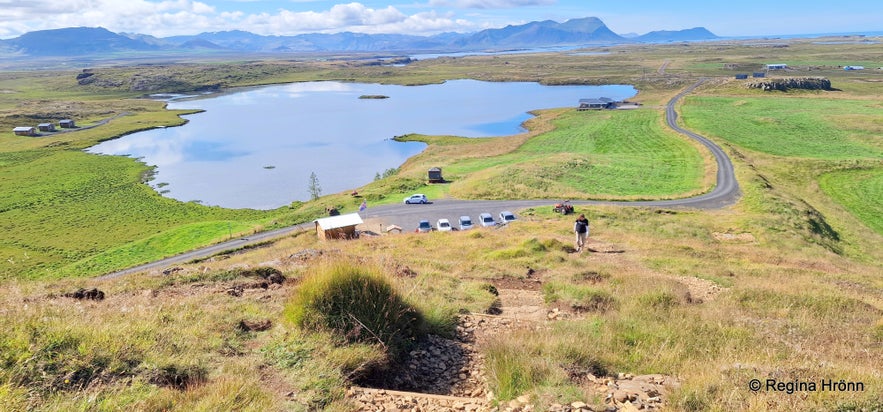 The view from the middle of the hike on Mt. Helgafell
The view from the middle of the hike on Mt. Helgafell
But seeing that you would have to pass by the farm at Helgafell, it disturbed the farmers on this working farm, as a whole lot of visitors hike up on top.
The farmers thus direct visitors to the hike on the west side of their farm.
This is controversial, but this is the home and workplace of the farmers and their families, so their wishes should be respected, even though this is one of the historic places on the Snæfellsnes peninsula.
The view-dial on top of Mt. Helgafell in Snæfellsnes in the dusk in 2015
Now, let's make 3 wishes (i.e. if you are visiting Mt. Helgafell for the first time) and hike to the top of the small mountain without looking back or uttering a word.
When you reach the top, you should go to the ruins of a prayer chapel on top of the mountain, look east, and think about your wishes (which shall all be positive), and don't tell anybody what you wished for.
May your wishes come true :) When I first hiked to the top of Mt. Helgafell back in 2008, my 3 wishes came partly true.
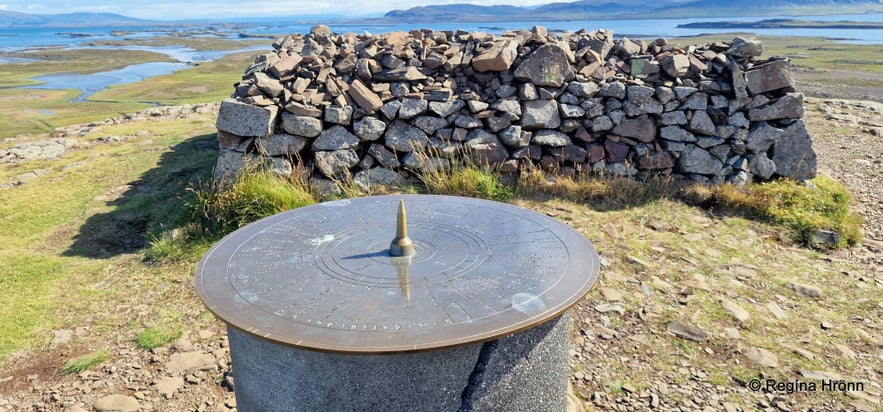 The view-dial and the ruins in the summer of 2025
The view-dial and the ruins in the summer of 2025
We don't know for certain if this old stacked wall on top of Mt. Helgafell is a prayer chapel or something else, but it is called Kapellan - the Chapel.
It is believed to have been a part of the old monastery and thus dates back to 1184.
It can also have been an old watchtower or an Irish chapel, who knows? As such, it should not be disturbed in any way.
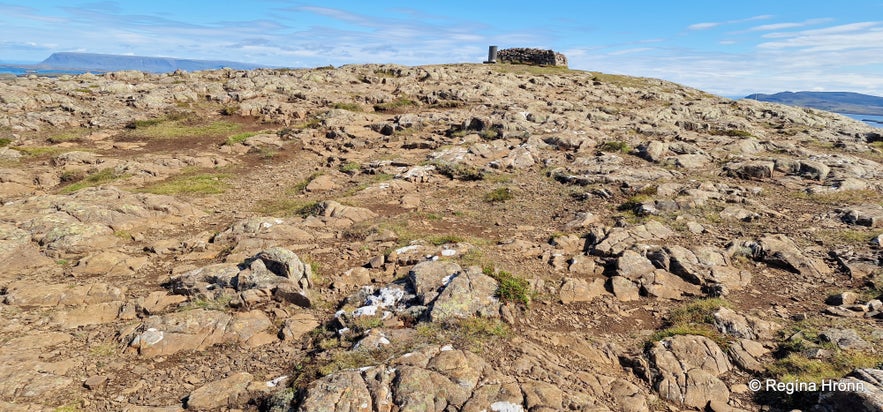 Almost at the top of Mt. Helgafell
Almost at the top of Mt. Helgafell
So many things must have happened here on the top of Mt. Helgafell.
Here Snorri goði sat with Víga-Styr and planned how Víga-Styr could kill the berserk who wanted to marry his daughter, Ásdís. Víga-Styr killed both the berserks, and Ásdís became Snorri's wife.
I tell you this story in another travel-blog:
Berserkjagata on Snæfellsnes Peninsula - is this the Oldest Man-made Road Construction in Iceland?
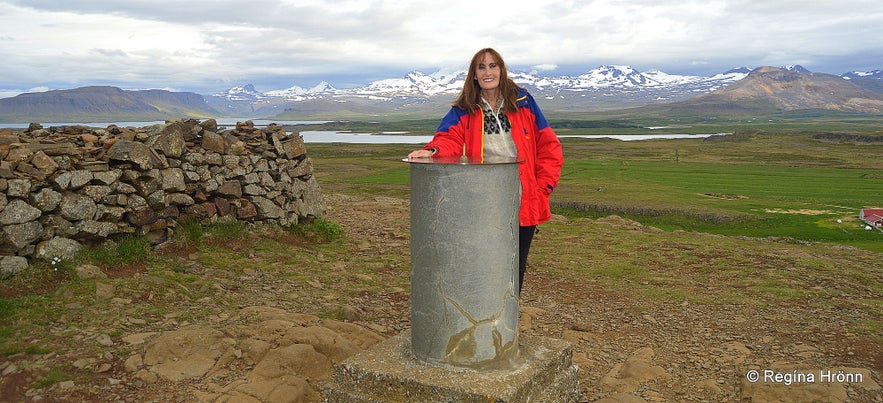
On top of Mt. Helgafell
You will find a view-dial (hringsjá) on top of Mt. Helgafell, erected in 1977.
The Rotary Club of nearby Stykkishólmur had it made in memory of Guðmundur Guðjónsson from Saurar.
It is one of the view-dials designed by the instigator of view-dials in Iceland, the noted Jón J. Víðis, who was my husband's great-uncle and namesake. Jón designed all in all 23 view-dials.
After his time, Jakob Hálfdanarson, my father-in-law, has been the main designer of view-dials in Iceland.

The view-dial on top of Mt. Helgafell
I visit all the view-dials I can get to on my travels in Iceland and photograph them, as they are of great interest to me. I hope you appreciate my effort in introducing them to you.
I will not be able to visit the view-dials located on tall mountain tops though, as my forte does not lie in hiking up mountains, unless up small mountains like Mt. Helgafell ;)
This view-dial shows the names and heights of all the mountains in the surrounding area. Engraved on the view-dial is that Mt. Helgafell is 78 meters above sea level.
The view-dial on top of Mt. Helgafell
The view from the top of Mt. Helgafell is beautiful in all directions, extraordinary really. In the north direction, you will see Stykkishólmur town and the innumerable islands on Breiðafjörður bay, but these islands are on the list of 3 innumerable things in Iceland.
On Mt. Helgafell, no man nor animal should be killed, and the settlers believed that they would go into the mountain after their death, as I told you earlier.
Let's respect this sacred place and not dislocate rocks or leave anything behind. One never knows what repercussions it can have, whether we believe in it or not!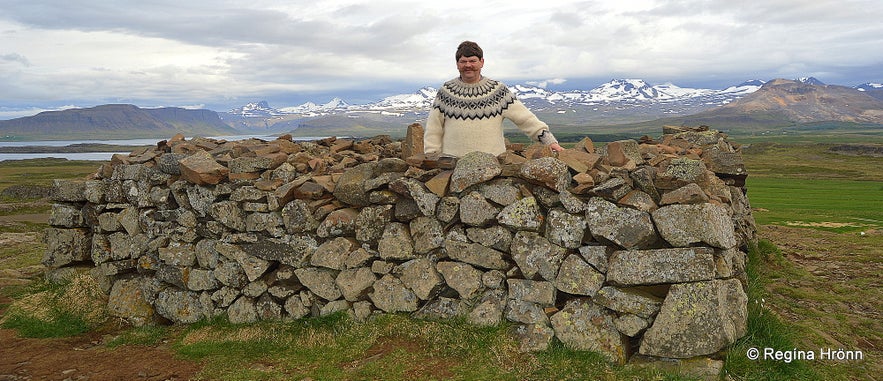
The ruins of what might be a prayer chapel on top of Mt. Helgafell
Now, let's return to the car via the same path on the west side of the mountain. Since I have hiked up on top of Mt. Helgafell so many times, I have hiked on both sides of the mountain.
The traditional path on the east side from Guðrún's grave has been closed off now.
When we meant to descend, we had to look for the path, but finally found it marked by two large flower pots.

The view from Mt. Helgafell
Let's join hands and respect nature and historic places in lovely Iceland and never leave trash behind in nature, build stone piles, or dislocate rocks.
Helgafell and the Giantess
An old bell in Helgafellskirkja church
On Hvítbjarnarey island (Polar bear island) in nearby Breiðafjörður, there is a boulder in a rift in the rocks.
It is of a different material than the other rocks on the island, and the origin of this particular boulder is explained in Þjóðsögur Jóns Árnasonar - the Compilation of Folklore of Jón Árnason, which I often refer to in my travel-blogs:
"Several stories exist of the giantess, who lived in Helgafellssveit region or in the mountains around here, first at Helgafell, but as a church was erected at Helgafell, the giantess moved to Mt. Kerlingarfjall.
The following are three of these stories of the giantess.
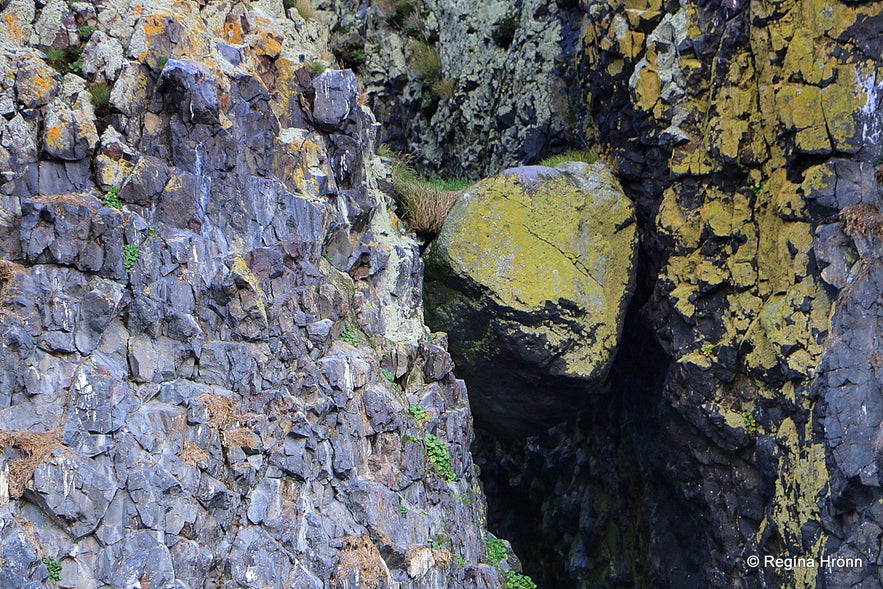
The boulder is of a different material than the rocks
Hvítabjarnareyja island (Polar bear island) is one of the islands above Stykkishólmur in Breiðafjörður.
It was named after a polar bear, which came ashore on the island and lay to rest on a stall on the southern part of the island, which is surrounded by tall cliffs.
A giantess was on the mainland, and people say that she lived at Helgafell before Christianity was adopted in Iceland, and a church was erected at Helgafell, but trolls are no fans of Christianity and churches.
And they especially don't like hearing church bells ringing.
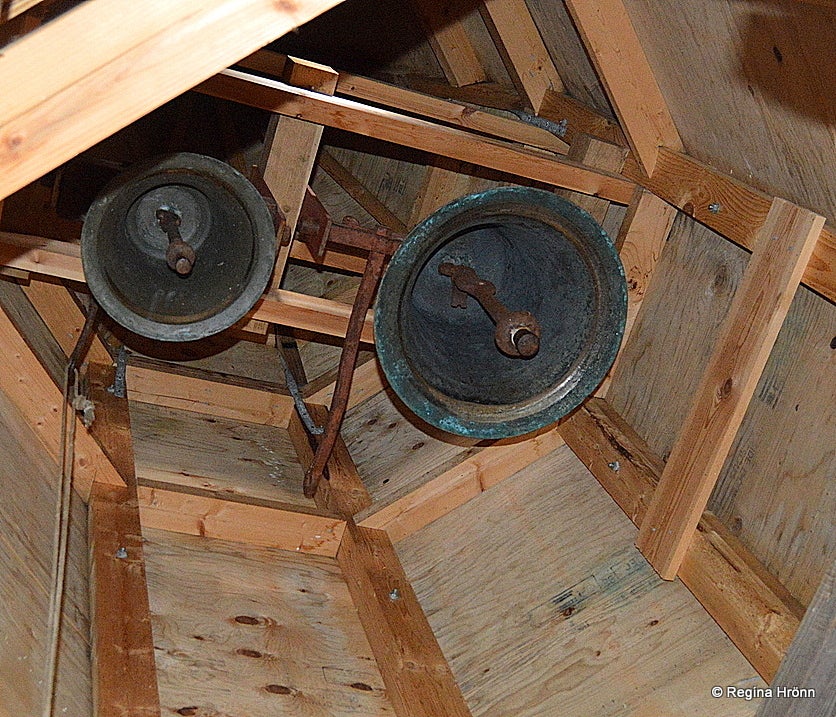
Church bells in Helgafellskirkja church
The giantess noticed that the polar bear was on the aforementioned stall on the island, and thus she walked on top of Þingvallaborg, which is opposite the island from the mainland, and threw a huge boulder over to the island to kill the polar bear.
But as fate has it, the boulder landed higher up than she intended and landed on the cliff tops, which are above and on both sides of the stall.
The boulder still lies above the stall, but the polar bear didn't get hurt.
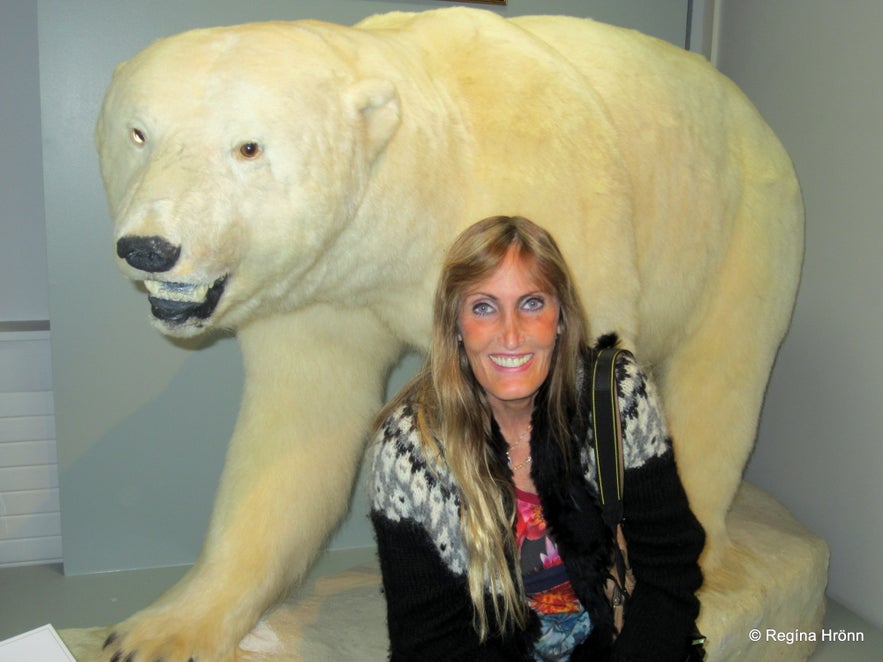 A polar bear that came ashore in Iceland
A polar bear that came ashore in Iceland
Another account from this region in the west is that the giantess who lived in Mt. Kerlingarfjall noticed that a man had gone fishing on a boat on Hrappseyjarsund strait, between Hrappsey island and Stykkishólmur.
The Giantess had a grudge against this man, the reason is not mentioned in the account, and threw a huge rock towards the man sitting in his boat, but that rock landed on Hvítabjarnarey island and can still be seen there, but the giantess failed to kill the man.
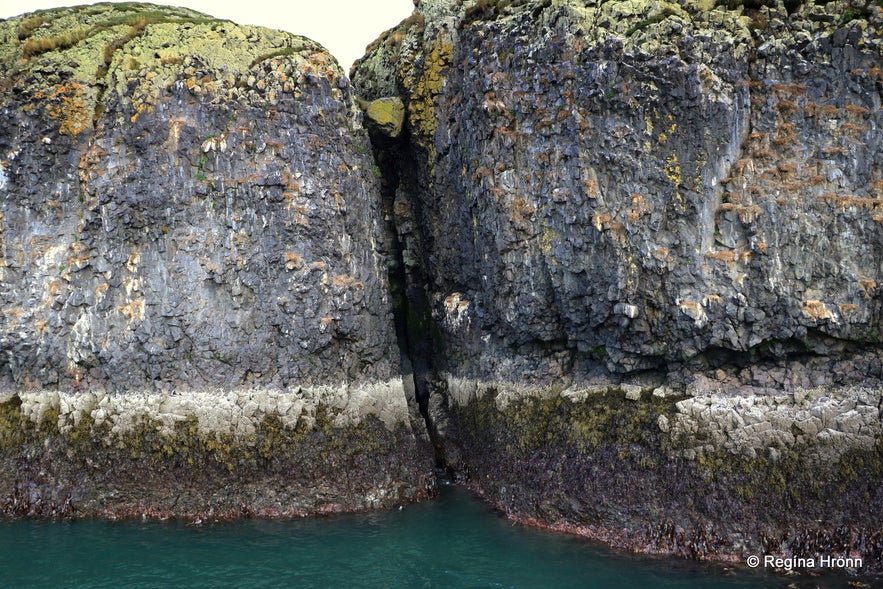
Hvítabjarnareyja island in Breiðafjörður and the boulder
Close to Nesvogur by Stykkishólmur, one can find 3 little hummocks, which are believed to have been thrown there by the giantess in Kerlingarskarð cleft, but she meant to destroy the church at Helgafell with these hummocks".
(Translated into English from Þjóðsögur Jóns Árnasonar - the Compilation of Folklore of Jón Árnason).
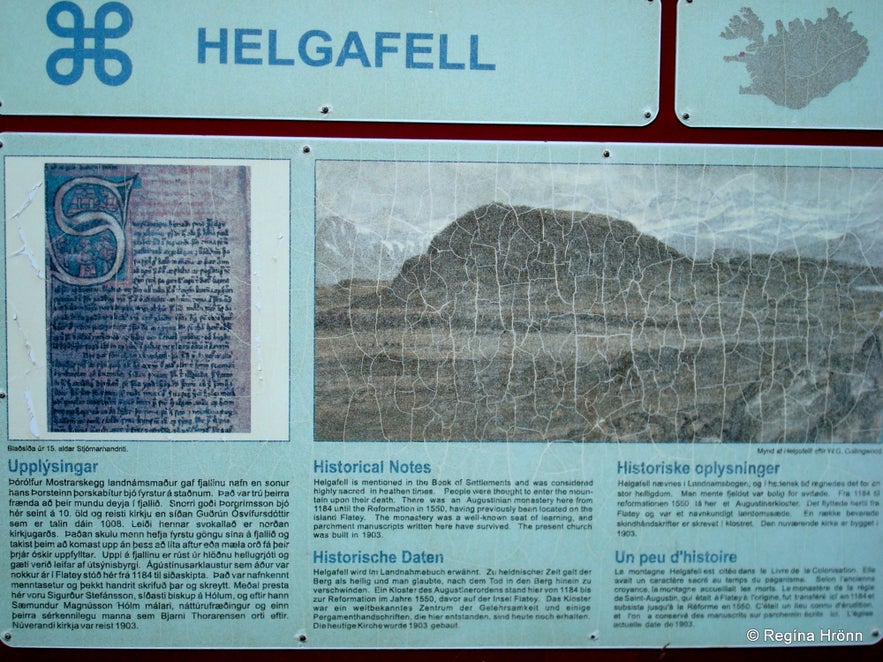
The information sign by Mt. Helgafell
See also:
Kerlingarskarð Pass in Snæfellsnes in West Iceland - the Folklore of the Giantess & her Fiancé
I have also heard that the boulder is said to have been thrown there by the giantess, who lived at Helgafell, as she wanted to destroy the church at Mt. Helgafell by throwing the boulder at it.
She missed her target, and the boulder landed here on this island.
Stykkishólmur, the capital of the West, is very close to Mt. Helgafell, and there you will find hotels and guesthouses, restaurants and cafés, shops and a supermarket, and interesting museums and galleries.
You can also stay in cabins near Helgafell:
Helgafell 2: Studio Cabin by the Lake
Helgafell | West Iceland Cabin Near Stykkishólmur
See also:
The Magical Snæfellsnes Peninsula in West Iceland - Part V - Stykkishólmur & the Trip back to Reykjavík
I have written detailed travel-blogs in 5 parts about the Snæfellsnes peninsula in chronological order, if you want to drive there yourself and prepare for the journey.
Have a lovely time on the Snæfellsnes peninsula :)


